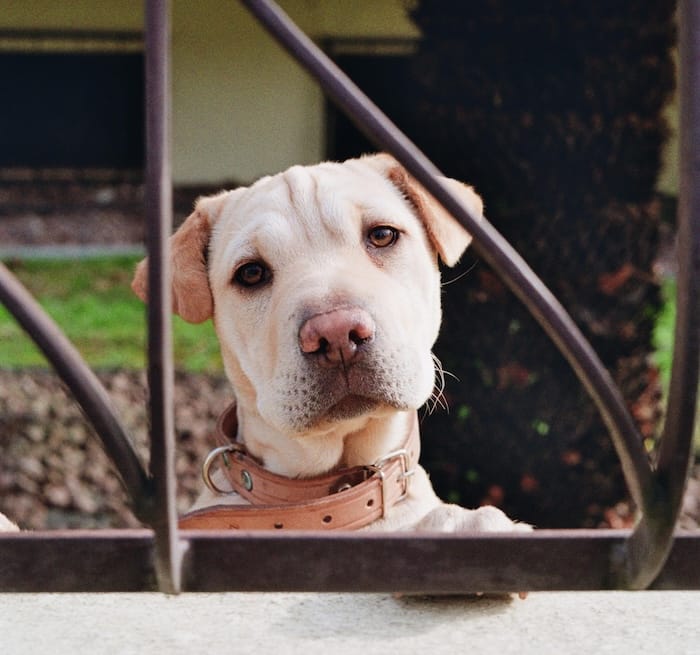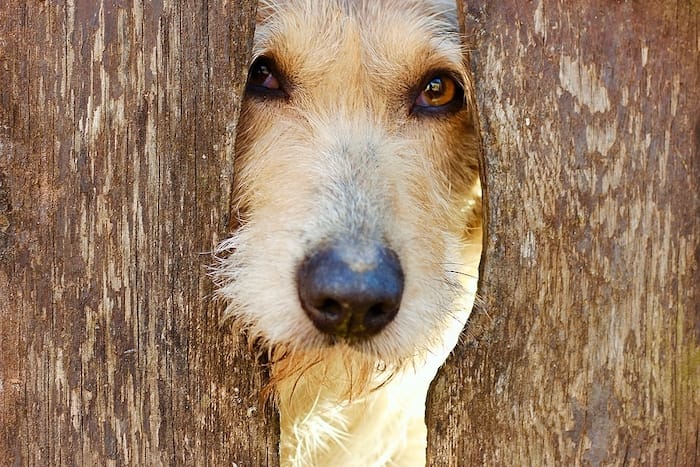As pet owners, we grasp the need to provide our large dogs with a safe and controlled environment in which to move around. This is where dog gates come into play. However, the selection and implementation of these gates is not always straightforward. From understanding the different types of gates to selecting the appropriate size and material, safety features to look out for, and even training your dog to use the gate, there is a complex array of considerations. Let’s explore these aspects further to make a well-informed decision that suits both your needs and those of your beloved pet.

Understanding the Need for Dog Gates
Why is there a growing demand for dog gates, particularly for larger breeds? The answer lies in both the behavioral impacts of such physical boundaries and the strategic gate positioning in households.
Dog gates serve as effective training tools, fostering desirable behavior while discouraging negative ones. For large dogs, these gates are instrumental in establishing house rules, maintaining order, and promoting safety. Their size and strength present unique challenges, making a dog gate essential for controlling their movement. Additionally, they mitigate potential damage to household items that may incur due to unrestrained activity.
Gate positioning plays an essential role in maximizing the efficacy of dog gates. Strategic placement in high-traffic areas or near specific rooms can curtail unwanted behavior, such as sneaking into the kitchen or climbing stairs. For larger breeds, positioning the gates at their eye level can enhance their perception of the boundary, thereby reducing attempts to jump or push it over.
Different Types of Dog Gates
Having established the importance and strategic use of dog gates for larger breeds, it is pertinent to explore the various types available in the market, which cater to different needs and preferences of dog owners.
There are three primary types of dog gates: freestanding, pressure-mounted, and hardware-mounted. Freestanding gates are independent structures, ideal for temporary or mobile needs. They can be easily moved around, providing flexibility for the dog owner. The gate aesthetics of these models are generally quite pleasing, often crafted from fine wood or sturdy metal, blending seamlessly with home decor.
Pressure-mounted gates, on the other hand, are held in place by pressure against doorframes or walls. These are perfect for doorways and hallways, although they mustn’t be used on top of staircases due to safety concerns. Innovative designs in this category have expanded to include one-touch-release handles and auto-close mechanisms.
The Importance of Size in Dog Gates
A dog gate’s size plays a pivotal role in its effectiveness, particularly when dealing with larger breeds, and must be meticulously considered to guarantee the safety and comfort of your pet. The perfect gate height for larger dogs should surpass their shoulder height to prevent them from leaping over it. Width is also of paramount importance, as a gate that’s too narrow might restrict the dog’s movement, leading to discomfort or even injury.
Gate aesthetics, though secondary to the functionality, should not be overlooked. A well-designed gate can enhance the overall decor of your abode while serving its purpose. Aesthetically pleasing gates often feature intricate designs and often come in various sizes to accommodate different breeds.
Personalized gates offer the best of both worlds by allowing pet owners to customize both the size and design of the gate. This ensures that the gate is not only the perfect fit for your pet but also complements your interior design.

Materials Used in Dog Gates
The selection of material used in the construction of dog gates greatly impacts the gate’s durability, functionality, and aesthetic appeal, with common materials ranging from metal and wood to plastic and fabric. Metal gates, typically constructed from steel or aluminum, offer robust strength, making them ideal for large and active dogs. Their sleek design contributes to gate aesthetics, adding a touch of sophistication to your home.
Wooden gates, on the other hand, provide a classic and warm aesthetic, often preferred for their customizable designs. They’re robust and durable, but their longevity depends on the finish used. Unfinished wood may succumb to moisture, leading to warping or rot.
Plastic gates are lightweight and portable, making them suitable for temporary or mobile solutions. However, their durability might not match up to metal or wood, particularly for larger breeds. For those seeking a less obtrusive option these transparent dog gates combine the lightweight, easy-to-move benefits of plastic with a stylish transparency that blends seamlessly into any decor. Finally, fabric gates, usually composed of nylon or mesh, are easy to install and remove, but their durability is limited and might not withstand the force of larger dogs.
Safety Features to Look For
When considering the purchase of a dog gate for large breeds, it is imperative to evaluate various safety features. These include sturdy locking mechanisms that prevent unintended escapes, the use of non-toxic materials to guarantee the health of your pet, and appropriate height and width to suit the size of your dog. Each of these factors plays a substantial role in providing a safe and secure environment for your pet.
Sturdy Locking Mechanisms
Ensuring the safety of your large-breed dog involves selecting a gate that features a robust and secure locking mechanism. Lock durability is a critical factor to contemplate. A high-quality lock is designed to withstand the force exerted by a large dog, ensuring it remains securely closed even when subjected to substantial pressure. In addition, child proof features are essential in households with small children. This includes a complex locking system that a child cannot easily open, but is still simple for adults to operate. Research shows that sturdy locking mechanisms, combining lock durability and child proof features, greatly reduce the risk of accidental escapes or injuries, thereby enhancing the overall safety of your pet and family.
Non-Toxic Material Choices
Prioritizing non-toxic material choices in dog gates is a critical safety measure, particularly for large dogs who are more likely to chew or gnaw on the gate. Opting for eco-friendly alternatives made from natural materials such as bamboo or sustainably sourced wood not only reduces environmental impact but also decreases the risk of exposing your pet to harmful chemicals found in plastic or metal gates. Understanding material allergy concerns is essential. Some dogs may have adverse reactions to specific materials, resulting in skin irritations or respiratory issues. It is advisable to choose a gate material that is hypoallergenic. To sum up, selecting a dog gate made of non-toxic, eco-friendly materials is a significant step towards ensuring your dog’s safety and well-being.
Height and Width Considerations
An equally crucial aspect to take into account when selecting a dog gate for large dogs is the gate’s height and width, both of which directly affect the effectiveness of the containment barrier and the safety of your pet. A gate that is too low may invite escape attempts, potentially endangering your pet and damaging the gate. Conversely, a gate that is too high might obstruct visibility and impinge on gate aesthetics. Width-wise, the gate should span the entire length of the doorway or opening for best containment. Essentially, the ideal gate combines functionality with aesthetics. Consider also the gate portability. A lightweight, adjustable gate allows for easy relocation, ensuring effective containment across varying spaces within your home.
Installation Methods for Dog Gates
When considering the installation of dog gates for large dogs, one must take into account various methods, each with their unique set of advantages and requirements. Factors such as gate aesthetics and gate mobility can greatly impact the installation process.
Freestanding gates offer a mix of aesthetics and mobility. They are designed to stand independently, so no mounting is required. This allows for easy relocation around the home, providing flexibility in use. However, the gate’s aesthetic appeal may be compromised if stability is prioritized over design.
Pressure-mounted gates, on the other hand, are installed by exerting pressure on the door frame or walls. Their mobility is limited, but they offer a clean, drill-free aesthetic. They are ideal for locations where frequent relocation is not necessary.
Finally, hardware-mounted gates are the most secure. They are permanently affixed to the wall or door frame using screws. This stability comes at the cost of mobility, but they offer a seamless aesthetic.
Selection should be based on the lifestyle needs and the physical layout of the home. It is important to follow the manufacturer’s instructions to make sure proper installation, safety, and functionality of the dog gate.
Considering Your Dog’s Size and Strength
Beyond the installation methods, it is important to account for the size and strength of your dog while selecting an appropriate gate. The dimensions and robustness of the gate must be proportionate to the dog’s size and physical capability. A gate that is too low for a large dog, or too flimsy for a strong one, will fail to serve its purpose.
Dog temperament also plays a vital role in this situation. A calm, obedient dog might respect the presence of a gate, regardless of its height or strength. Conversely, an assertive or high-energy dog may attempt to leap over or push through it. Hence, the gate’s design should be appropriate for your dog’s behavior and energy level.
Lastly, consider the breed-specific needs of your dog. Some breeds, such as the Bernese Mountain Dog or the Great Dane, can grow considerably large and strong, necessitating a sturdier, taller gate. Other breeds might have a natural propensity to jump high, requiring a gate of substantial height. Understanding your dog’s breed traits can help you select the most effective gate to guarantee their safety and containment.
Indoor Vs Outdoor Dog Gates
In the selection of dog gates, a critical factor to ponder is their intended location: indoors or outdoors. The conditions and requirements for each setting vary substantially, with indoor gates needing to blend with home decor and withstand dog’s strength, while outdoor gates should be resilient to weather conditions and provide a secure boundary. Subsequently, we will explore these specific considerations for indoor and outdoor gates to facilitate an informed decision-making process.
Indoor Gate Considerations
Understanding the key differences between indoor and outdoor dog gates is essential for making an informed decision that best suits the needs of your large dog. Indoor gates typically focus more on aesthetics, often designed to blend seamlessly with your home decor. However, it’s essential not to compromise on the gate’s functionality and durability. Large dogs can be quite strong and may exhibit behaviors such as jumping or chewing, hence a sturdy, non-toxic material should be a top consideration. Additionally, an indoor gate should have a secure latch system, yet allow easy human passage. It should also have minimal gaps to prevent small pets from squeezing through. When considering an indoor gate, balance between gate aesthetics, dog behavior, and safety is vital.
To conclude, when contemplating an indoor gate, balance between gate aesthetics, dog behavior, and safety is important.
Outdoor Gate Essentials
While indoor gates must harmoniously blend with home decor and offer a secure environment for your large dog, outdoor gates present a different set of considerations and challenges. Gate aesthetics for outdoor gates should ideally complement the exterior of your home while maintaining functionality. They should be constructed from materials that can withstand differing weather conditions, ensuring weather durability. A well-designed outdoor gate should resist damage from extreme heat, heavy rain, snow, and even high humidity levels. The chosen material, whether metal, wood, or plastic, should be resistant to rust, decay, and UV damage. The gate’s structural integrity must remain high over time, providing uninterrupted safety for your dog while enhancing the visual appeal of your outdoor space.
Picking the Right Gate for Your Space
Selecting an appropriate dog gate necessitates careful consideration of your living space, focusing on factors such as the size, layout, and the specific needs of your large dog. Gate placement is a critical component of this decision-making process. For best space utilization and seamless movement, the gate should ideally be placed in a location that does not obstruct regular foot traffic, while still effectively restricting your dog’s access to designated areas.
The architecture of your space, including the presence of wide doorways or open floor plans, might necessitate specific gate designs. For instance, freestanding gates can be advantageous in larger, open spaces, while pressure-mounted gates might be more suitable for narrower doorways.
Space optimization is key in ensuring the gate serves its purpose without becoming a hindrance. A gate that is too large can make navigation cumbersome, while one that’s too small might be ineffective for a large breed dog. Therefore, carefully measuring your space, and factoring in your dog’s size and agility, is essential to make an informed choice. The right gate should strike a balance between functionality, aesthetic appeal, and spatial harmony.

Gate Maintenance and Durability
When considering the longevity and performance of dog gates, meticulous attention should be paid to both the maintenance requirements and inherent durability of the product. A well-constructed gate will not only withstand the physical pressure of a large dog but also maintain its structural integrity over time, despite wear and tear.
Materials such as robust steel or reinforced plastic, offering high resistance to deformation, are typically used in creating these gates, ensuring their durability. However, the maintenance required for these materials can vary. For instance, steel gates may need occasional rust proofing, while plastic gates may require frequent cleaning to prevent bacteria build-up.
Gate aesthetics should not be overlooked, as it intertwines with its durability. For example, a gate with a scratch-resistant finish will preserve its aesthetic appeal longer. Additionally, the design should allow for gate mobility, enabling the gate to be relocated easily without compromising its structural stability. Such a feature enhances its usability while reducing the chances of damage during movement.
When selecting a dog gate, consider its durability, maintenance requirements, aesthetic appeal, and mobility. These factors play a crucial role in the lifespan and effectiveness of the gate.
Training Your Dog to Use the Gate
Having chosen a suitable gate that meets all the durability and maintenance requirements, the next step involves training your large dog to become accustomed to using the gate. This process, often termed as gate etiquette, involves a series of systematic behavioral modifications which, if executed correctly, can help your dog adapt to the gate with ease.
The first imperative step is to introduce the dog to the gate in a calm and controlled environment. This will enable the dog to perceive the gate as a non-threatening object. Next, you should gradually train your dog to walk through the gate under your supervision. This procedure should be repeated until your dog can successfully pass through the gate without any signs of anxiety or hesitation.
A reward system is a important part of this training process. Positive reinforcement, such as giving treats or verbal praise, when your dog uses the gate correctly, can significantly boost the learning process. It is important to note that patience and consistency are important in this process.
Cost and Value Considerations for Dog Gates
In evaluating the financial implications of acquiring a dog gate, one must consider both the upfront cost and the long-term value derived from the product’s durability, functionality, and ease of maintenance. Budgeting for gates requires a thorough analysis of the market, taking into account the variability in prices due to factors such as size, material, and additional features.
When it comes to value comparison, the cheapest option may not always provide the best value. A gate made of durable materials, while potentially more costly initially, might offer better value over time due to its increased longevity. The functionality of the gate should also be a primary consideration. A gate that can be easily adjusted to fit varying door widths, or one that offers a walk-through design for human convenience, could be of higher value.
Given the cost associated with replacing a faulty or inadequate gate, investing in a high-quality product could end up being more cost-effective in the long run. Thus, potential buyers should not only consider the initial outlay but also the enduring value and utility of the dog gate.
Frequently Asked Questions
What Should I Do if My Large Dog Is Able to Jump Over the Gate?
If your large dog can jump over the gate, consider gate height adjustment. Reinforcement options, such as adding extensions or selecting a taller model, may also be needed to prevent your pet from jumping over.
How Can I Introduce the Concept of a Dog Gate to My Large Dog Without Causing Anxiety?
Introducing a dog gate to your large dog involves careful gate selection and anxiety management. Start with gradual introduction, allowing the dog to explore the gate. Positive reinforcement can help ease anxiety and promote acceptance.
Are There Any Specific Brands of Dog Gates That Are Recommended for Large Dogs?
Yes, certain brands prioritize gate durability and installation ease for large dogs. Noteworthy, Hiddin offer robust, easy-to-install gates specifically designed to accommodate larger breed dogs efficiently and safely.
Can Dog Gates Be Used for Other Pets in the House Like Cats or Rabbits?
Yes, dog gates can be used for other pets such as cats or rabbits, but pet compatibility largely depends on the gate material. Make sure the gate is sturdy and secure enough for each specific pet.
Are There Any Potential Health Impacts on My Large Dog Due to the Use of a Dog Gate?
Dog gates, if used appropriately, should not pose health risks to large dogs. However, gate material importance is vital to prevent injury. Poorly designed gates could impact mobility, leading to muscle strain or joint issues.
